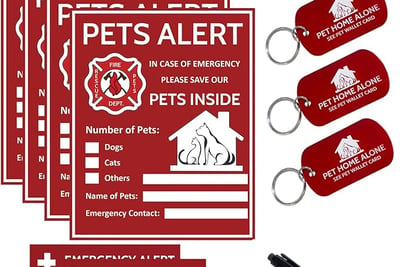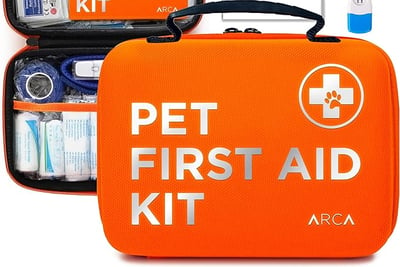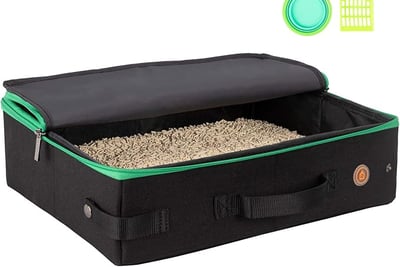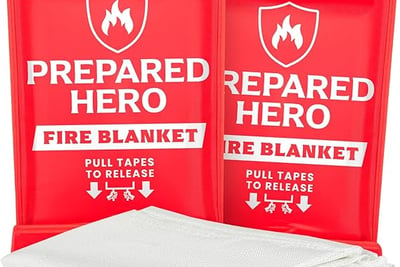Creating an Emergency Plan for Your Cat: How to Get Out Safely and Quickly
8 min read


Understanding the Importance of an Emergency Plan for Your Cat
In today’s unpredictable world, the significance of having an emergency plan for pets, particularly cats, cannot be overstated. Emergencies can arise without warning, ranging from natural disasters such as floods, fires, and earthquakes, to unforeseen accidents or sudden evacuations due to a variety of reasons. In such challenging circumstances, the safety and well-being of our feline companions often depend on the readiness of their owners to respond effectively.
Statistics indicate that a considerable number of pets become lost during emergencies. For instance, according to the American Society for the Prevention of Cruelty to Animals (ASPCA), it is estimated that up to 60% of pets are lost after a disaster. The emotional toll of being separated from a pet can be devastating, not only for the animal but also for its owner. Cats, known for their instinctive behavior to hide when frightened, may become disoriented and difficult to locate in stressful situations. Thus, the implementation of a well-thought-out emergency plan significantly enhances the likelihood of reunion amidst chaos.
Moreover, cats are creatures of habit, and sudden changes in their environment can lead to anxiety and stress. An emergency plan provides a sense of security for both pets and their owners during distressing times. By preparing in advance, pet owners can ensure that their cats have essential supplies, such as food, water, identification, and comfortable bedding, readily available to ease the transition in case of an evacuation. This preparation not only minimizes the panic that accompanies emergencies but also fosters a safer and more organized approach that prioritizes the well-being of our feline friends.
Assessing Your Cat's Unique Needs and Behavior
Understanding your cat's unique needs and behavior is crucial for developing an effective emergency plan. Each cat possesses its own temperament, habits, and preferences that can significantly influence how they react in stressful situations, such as being confined or transported. By observing your feline companion in various contexts, you can better assess their responses and plan accordingly to mitigate stress during emergencies.
Begin by evaluating your cat's temperament. Some cats are naturally more anxious, while others may be confident and adaptable. Recognize your cat's triggers; for instance, a sudden loud noise or unfamiliar environment may provoke fear. Take note of how your cat behaves when introduced to new experiences, such as travel in a carrier or meeting new people. These observations will help inform your emergency preparations and identify what may exacerbate stress during a crisis.
Additionally, recognize your cat's habits and routines. Cats thrive on familiarity, so disruptions to their daily schedule can lead to anxiety. Pay attention to their preferred resting spots, feeding habits, and interaction preferences. Understanding where your cat feels most comfortable can assist in creating a designated safe space that they can retreat to during emergencies.
Moreover, consider your cat's individual preferences regarding confinement and transport. Some cats may resist being placed in carriers, while others may be accustomed to them. Experiment with acclimating your cat to the carrier before an emergency arises; this can be achieved by making it a comfortable space, filled with familiar items, and allowing your cat to explore it freely.
By attentively assessing your cat's unique needs and behaviors, you can devise strategies to ease potential stressors. These strategies may include utilizing calming pheromones, creating a soothing environment, or preparing a specialized emergency kit that aligns with your cat's preferences, ultimately ensuring a safer and more efficient escape during an emergency.
Creating a Comprehensive Emergency Kit for Your Cat
Having a well-stocked emergency kit for your cat can be crucial during a crisis. An emergency situation can arise unexpectedly, and being adequately prepared is essential for safeguarding your feline companion. Here are key items to include in your cat’s emergency kit:
Food and Water: At least a two-week supply of your cat's preferred food is vital. This should be in sealed, waterproof containers to ensure freshness. Additionally, store at least one gallon of water per cat per day. Hydration is crucial, especially during stressful situations, so consider including collapsible bowls for easy feeding.
Medications: If your cat requires any medications, ensure you have an ample supply in your emergency kit. This includes not only prescription medications but also any over-the-counter drugs your veterinarian might recommend. Make sure to include detailed instructions regarding dosages and administration, as this information will be invaluable if alternative caregivers need to manage your cat's health.
Identification Tags: Each cat should have proper identification, including a collar with an ID tag containing your contact information. Microchipping is also highly encouraged, as it increases the likelihood of reunification if your cat gets lost. Make sure to keep your contact details updated with the microchip registry.
Carrier: A sturdy and comfortable cat carrier is essential for evacuation. Your cat should feel secure inside the carrier, and being accustomed to it beforehand can reduce stress during an emergency. Ensure that the carrier is well-ventilated and has a soft bedding to provide comfort.
First Aid Supplies: Including a basic first aid kit specifically designed for pets can be beneficial. Equip it with items like bandages, antiseptic wipes, and any tools that may assist in administering care until professional help can be reached. Familiarize yourself with basic animal first aid, as this knowledge can be invaluable in emergencies.
By preparing an emergency kit tailored for your cat, you can ensure that you are well-equipped to meet your pet's needs during any crisis. Recognizing the importance of these items will not only help to keep your cat safe but also provide peace of mind in challenging times.
Establishing an Evacuation Plan and Routes
Creating an effective evacuation plan for your cat is essential in ensuring their safety during emergencies. The first step is to identify multiple escape routes from your home. Consider all exits, including doors and windows, and plan for different scenarios. This way, whether you face a natural disaster, fire, or any other emergency, you and your cat can quickly access a safe exit. Familiarity with these routes can significantly reduce panic during a crisis.
After establishing escape routes, it's paramount to pre-select safe locations where you can take your cat. Friends, family members, or local pet-friendly shelters can serve as temporary safe havens. Ensuring these locations understand you are bringing a cat ahead of time will help in any emergency situation. It’s advisable to have a list of these safe places readily accessible, both physically and digitally, so you can act promptly when needed.
Practicing evacuation drills with your cat is vital for an effective emergency response. Introduce your cat to their carrier and make it a positive experience by using treats and praise, which will help them feel more comfortable during an actual evacuation. Subsequently, practice moving your cat in and out of the carrier and using your identified escape routes. Rehearsing will provide you with a clear action plan and help your cat associate the carrier and the evacuation process with a sense of security rather than fear.
By taking these steps, you lay the groundwork for a well-prepared evacuation plan that not only prioritizes your safety but also ensures your cat remains calm and secure. Regular plan reviews and updates will help accommodate any changes in your home layout or the needs of your pet, contributing to a comprehensive emergency strategy.
Training Your Cat for Emergency Situations
Preparing your cat for emergencies involves a blend of effective training techniques that can facilitate quick exits when every second counts. One fundamental aspect is desensitization to carriers, which can often be a source of anxiety for felines. Start by associating the carrier with positive experiences; leave it open in a comfortable space and encourage your cat to explore it at their own pace. Utilize treats, toys, and gentle encouragement to create a positive association. Over time, your cat will become accustomed to the carrier, reducing panic during an emergency.
Positive reinforcement plays a crucial role in this training. When your cat enters the carrier willingly or remains calm, reward them with treats or affection. This method reinforces the behavior you wish to cultivate, making your cat more likely to cooperate under stressful circumstances. Additionally, incorporate training sessions that focus on basic commands, such as “come” or “sit.” Familiar commands can make it easier to direct your cat in chaotic situations, which is essential when time is of the essence.
Creating a calm environment is pivotal during training. If your cat senses tension or anxiety, they may become agitated themselves. Choose a quiet space for training sessions and keep distractions to a minimum. Gradually introduce noise or sudden movements to mimic the chaos of an emergency, while ensuring that your cat remains calm. Gradual exposure will help acclimate them to potential triggers. Establishing a regular routine reinforces these training practices, allowing your cat to feel secure and prepared. Schedule periodic drills that simulate emergency scenarios, where you practice getting your cat into the carrier within a specified time frame. Regularly practicing these techniques strengthens your cat's confidence and adaptability, making them more resilient during actual emergencies.
Communication and Information Sharing with Reviewers and Caregivers
Effective communication is a cornerstone of any emergency plan, particularly when it involves the safety and well-being of your cat. Establishing a robust communication system ensures that all caregivers—be they pet sitters, friends, or family members—are adequately informed and prepared to execute the emergency plan. It is essential to develop a clear and concise method for disseminating information regarding emergency procedures that pertain to your cat.
First and foremost, it is vital to identify who will be responsible for your cat's care in the event of an emergency. Engage these individuals early in the planning process to ensure they fully understand their roles. Sharing your emergency plan with them can be facilitated through a combination of verbal discussions and written documentation. Detailed descriptions of what needs to be done during various emergency scenarios can help caregivers act quickly and efficiently. Additionally, consider creating a group chat or emailing list where updates and any necessary alterations to the plan can be communicated seamlessly.
Another critical aspect of communication involves sharing vital information about your cat. Compile a comprehensive list of emergency contacts, including your veterinarian, a nearby animal hospital, and any others who may assist in your cat’s care. Additionally, document your cat's medical needs, dietary restrictions, and any specific behaviors that could affect safety or handling. For instance, knowing whether your cat is anxious around strangers or has medical conditions requiring special attention can greatly impact how caregivers approach the situation. This information will prove invaluable in ensuring that your cat receives the appropriate care and attention they need during an emergency. By prioritizing clear communication and thorough information sharing, you can enhance the readiness of those looking after your pet, ultimately ensuring a smoother and more effective emergency response.
The Importance of Regularly Updating Your Emergency Plan
Regularly updating your emergency plan is an essential component of pet ownership, particularly for cat owners who must ensure their furry companions are well-protected in crisis situations. Circumstances in life can change dramatically, whether due to a move to a new home, a shift in your cat's health status, or the emergence of new emergency resources within your community. By routinely reviewing and refreshing your plan, you can guarantee that it aligns with your current situation and provides the best possible outcomes for both you and your cat.
One of the primary considerations when revisiting your emergency plan is the frequency at which reviews should occur. It is advisable to assess your emergency plan at least every six months. This schedule allows you to make necessary adjustments based on changing circumstances, such as the age or health of your cat. For instance, if your cat develops a medical condition or requires specific medications, your emergency plan must reflect these needs to ensure their safety and well-being during emergencies.
Additionally, it is essential to update your emergency kit regularly. This kit should not only contain food, water, and medical supplies but should also reflect any changes in your cat's dietary needs or preferences. Replacing expired items and ensuring you have adequate supplies tailored to your cat will contribute significantly to your ability to respond effectively in an emergency. Consider incorporating lessons learned from any previous emergencies you may have experienced. Such experiences can provide invaluable insights that can enhance your preparedness for future situations.
In conclusion, preparation is ongoing, and consistently revisiting your emergency plan is crucial to ensuring the safety of your cat. By making it a routine practice, you will create a more resilient and supportive environment for your feline family member during times of crisis.











